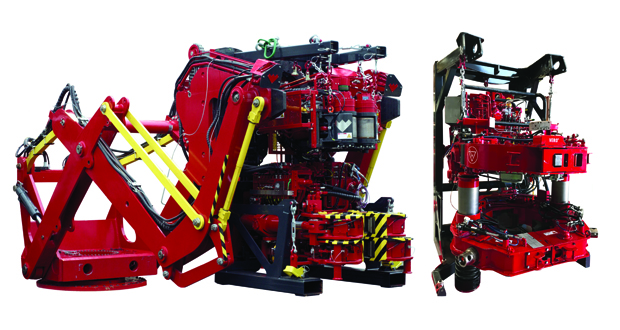Automation of tubular running services is set to transform rig floor operations
As drilling contractors take on additional services at the rig site, automated systems can fill competency gaps, improve efficiency

By Tracy Cummins and Scott McIntire, Weatherford International
All aspects of energy exploration and production improve over time as new technology changes the paradigms of how assets are extracted from reservoirs. What was once considered radical and industry leading can become outdated and inefficient with each new invention.
Tubular running services (TRS) is no exception. The process began with field personnel manually making up tubulars and running into the wellbore. It was time consuming, incurring significant nonproductive time (NPT), and was sometimes fraught with unintended errors that damaged the tubulars and periodically produced inconsistent connection makeup, resulting in frequent work stoppages to remake connections and lay down rejected joints.
In the mid-1990s, Weatherford developed a mechanized method to run tubulars. By using remote-controlled equipment instead of field personnel to manually position and operate TRS equipment, the industry improved safety by eliminating hands-on operations and removing field personnel from the red zone.
In more recent years, the arrival of digitalization into the oilfield allowed contractors access to computer control and artificial intelligence to deliver proper connection makeups. It also removed previously subjective decisions from connection makeup graph evaluations. Now, computer systems can be programmed with all the necessary parameters to automatically make up every type of connection, delivering precise, repeatable and consistent operations. Coupled with mechanized positioning systems, this new automation maintained an operational rhythm of casing and tubing running. Naturally, efficiency significantly improved, including reduction of the required personnel on the rig site and making the operation safer for the remaining personnel.
The next transformation

With thousands of connections made in any given operation, a single bad connection can compromise the integrity of the entire asset. To ensure consistent success, Weatherford has developed a means to validate every connection, from the wellhead to total depth (TD). Rather than rely on human judgement for connection evaluation, proprietary algorithms and artificial intelligence are applied to eliminate human errors.
The Vero Automated Connection Integrity system replaces human judgement with computer-controlled consistency and accuracy during the makeup of premium connections. With traditional makeup systems, the operator must acknowledge the completion of individual steps in the makeup process, analyze the connection and enter commands for the next function. Each of these commands encounters a bottleneck: A technician must make a decision and enter input before the tong moves to the next step. The Vero mechanized system performs them automatically. The only human action necessary is through a one-touch control.
With this automated process, certain personnel, like a torque-turn monitoring technician, are no longer required at the rig site. The remaining cross-trained technicians monitor all connections with a tablet or laptop from safe areas like the driller’s cabin. Engineers can also monitor progress from anywhere in the world.
Case studies

Over the past four years, the Vero system has been deployed on over 475 jobs in 24 countries and made up over 110,000 various premium connections. Automating the makeup process and the resulting reduction in thread damage has saved over 1,700 hours of rig time.
On a land-based gas well in the Middle East, an operator needed to reduce the number of rejected joints when running premium completion strings. Additionally, the rig-up and rig-down time needed to be minimized to prepare for completions running operations. The Vero system eliminated all rejected joints in multiple jobs, totaling more than 1,200 connections. It also helped to reduce TRS personnel at the rig site by 25%.
On multiple offshore operations, customers required similar objectives: enhance connection integrity, reduce or eliminate rejected joints, and decrease rig-up and rig-down times. Typically, the Vero system has averaged 30% less time for rigging compared with traditional equipment.
On one offshore project in the Gulf of Mexico, it improved overall running speed efficiency by 15% and achieved a rig time savings of 17 hours across two completions runs. This time savings was a result of fewer remakes and rejected makeups, and an overall faster joints per hour running tubulars into the wellbore.
In Kazakhstan onshore development wells, one prime objective was to expose fewer rig personnel to drill floor risks and improve operational rig time efficiency. The conventional version of the Vero system was used, which was designed for land and shallow-water rigs and requires manual positioning onto the pipe at the well center. The number of personnel required to perform the TRS was reduced by 30%, and the 19,000 connections on 65 jobs were made up with zero NPT. The operator saved $1.2 million in rig time.
Paradigm is shifting again
The oil and gas industry’s business model continues to change, with the dynamic between larger operators and drilling contractors shifting yet again. In the past, operators took on the responsibilities of sourcing TRS, as well as other services such as managed pressure drilling, remote-operating vehicles and cuttings management. Now, operators are frequently requiring drilling contractors to take on these services as part of drilling contracts. While this creates new challenges for drilling contractors, new technology can fill in the training and competency gaps.
Weatherford believes the key to success lies in the integration of TRS equipment into the drilling rig control and positioning systems. The process began decades ago with the integration of mechanized TRS controls into the driller’s chair. This enabled drillers to operate casing-running activities in the same manner as drill pipe. Although this reduced the number of personnel needed, it still required significant rigging times and the hands-on process of connecting equipment.
The Vero OneTouch Automated Tubular system, which consists of a pedestal-mounted, scissor-type positioning arm and separate cassettes for drilling, casing and completions, addresses this challenge. The key component is the automatic multi-coupler, which connects each cassette to the positioning system like a computer USB. It simultaneously connects electrical power, hydraulics and data in less than one minute, hands free. This system can be integrated into the driller’s chair, replacing the iron roughnecks and eliminating the need to call out third-party casing tongs.
On most deepwater projects, multiple well sections will require a transition from drilling to casing to landing operations. Generally, these transitions consume valuable time on the critical path and involve several personnel manually connecting and disconnecting drilling and casing equipment. With the OneTouch system, those complete transitions can be reduced as each hands-free cassette exchange can be accomplished in less than six minutes. Because the system is digital, remote diagnostics and troubleshooting can be performed by OEM engineers.
Drilling contractors have attempted to deliver TRS services in the past, yet faced difficulties keeping up with procedures for handling premium threaded connections. Additionally, third-party equipment is rigged up around their existing rig floor packages, adding casing personnel to the rig floor and potentially the red zone. Now, new technologies are poised to help drilling crews rig up, operate the equipment, and transition between drilling and casing with confidence. DC




